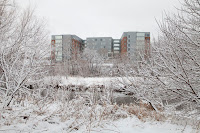“There are some who can live without wild things, and some who cannot. These essays are the delights and dilemmas of one who cannot.
Like winds and sunsets, wild things were taken for granted until progress began to do away with them. Now we face the question whether a still higher 'standard of living' is worth its cost in things natural, wild, and free. For us of the minority, the opportunity to see geese is more important than television, and the chance to find a pasque-flower is a right as inalienable as free speech.”
Like winds and sunsets, wild things were taken for granted until progress began to do away with them. Now we face the question whether a still higher 'standard of living' is worth its cost in things natural, wild, and free. For us of the minority, the opportunity to see geese is more important than television, and the chance to find a pasque-flower is a right as inalienable as free speech.”
The world has changed since Aldo Leopold wrote these opening lines to “A Sand County Almanac,” which was first published in 1949. Leopold would likely be saddened to see how many more of the wild places he so cherished have been diminished or have disappeared altogether. On the other hand, one can hope that he would be heartened by the tremendous increase in public awareness about the importance of ecology and concern for the natural world, and by ever more urgent efforts to preserve remaining wild lands all over the world.
Aldo Leopold himself, of course, was instrumental in sparking this increase in awareness and concern. For this reason the first weekend in March was officially designated in 2004 as “Aldo Leopold Weekend” here in his home state of Wisconsin.
Leopold spent most of his career in Wisconsin as a writer, forester, scientist and professor at the University of Wisconsin in Madison. In 1935, he bought a farm along the Wisconsin River near Baraboo. The farmland had been exhausted. He and his family set about restoring the land to a more native state, planting thousands of pine trees and reestablishing prairies.
That personal experience with ecological restoration and his meticulous documentation of consequent changes in the flora and fauna on the farm both inspired and informed his writings.
I recently pulled from my shelf a well-worn paperback copy of “A Sand County Almanac,” with its split binding, yellowed pages, and numerous underlined passages. The slim volume didn’t take long to reread. The familiarity of the stories didn’t diminish my delight in the quality of the prose and his ideas are if anything more important today than ever.
“There are two spiritual dangers in not owning a farm. One is the danger of supposing that breakfast comes from the grocery, and the other that heat comes from the furnace.”
The implications of that simple observation are as topical as the controversy over routing power lines through Milwaukee County Parkways or the dramatic increase in gas prices over the past two weeks.
Leopold’s most important contribution, arguably, is the idea that we need a “land ethic.” His brief “Almanac” is followed by a series of essays. It is in the concluding essay that Leopold makes his boldest statement and issues his most stirring call to action.
In general terms, ethics refers here to the unwritten rules and mores by which people live in community with one another. Leopold’s inspired notion is to expand our idea of community to include not just people but the natural world: plants, animals, the soil, water. Collectively, he called this “the land." Scientifically it is the biotic community.
The land ethic can be summed up, in Leopold’s words, as follows: “A thing is right when it tends to preserve the integrity, stability, and beauty of the biotic community. It is wrong when it tends otherwise.”
Even in places less well endowed with parks and rivers as Milwaukee County people need to be mindful of nature, of not dirtying the environment that sustains us. If that sounds obvious, perhaps it’s a good reason to celebrate Aldo Leopold Weekend – in remembrance of his influence on our culture.
You might ask, “How can I celebrate Aldo Leopold Weekend?” Well, I’m glad you asked. Here are a few suggestions:
1. You know what I like to do: go outside and enjoy the urban wilderness! Find a local park with natural areas and explore.
2. Visit the library, borrow a copy of “A Sand County Almanac” and read it with pleasure – or buy one that you can read over and over, as I have.
3. Go to the North Shore Library in Glendale at 1:30 pm on Saturday, March 3 to see “Green Fire.” A feature-length documentary about Aldo Leopold, “Green Fire” highlights his extraordinary career and his influence on the modern environmental movement.
4. Don’t forget to check out the Aldo Leopold Foundation website, which has a wealth of information about Leopold and the special weekend ahead. There’s even a Facebook photo contest.
If you’re more ambitious you can plan a trip to visit Leopold’s farm, which is managed by the foundation.
A note on the images that accompany this post: I shot them all last Friday morning right after the big, heavy snowfall. It may not be immediately clear how they represent Leopold’s vision of a healthy biotic community for I’ve deliberately chosen to find the ambiguity, if not the paradox, of urban nature.
But we need even these fragments to connect us to the larger land community. In his essay on the land ethic Leopold himself observed, "The weeds in a city lot convey the same lessons as the redwoods."
For a more typical selection of urban wilderness photos, also from Friday morning, scroll down to my previous post. I am, after all, one of those who cannot live without wild things.





















